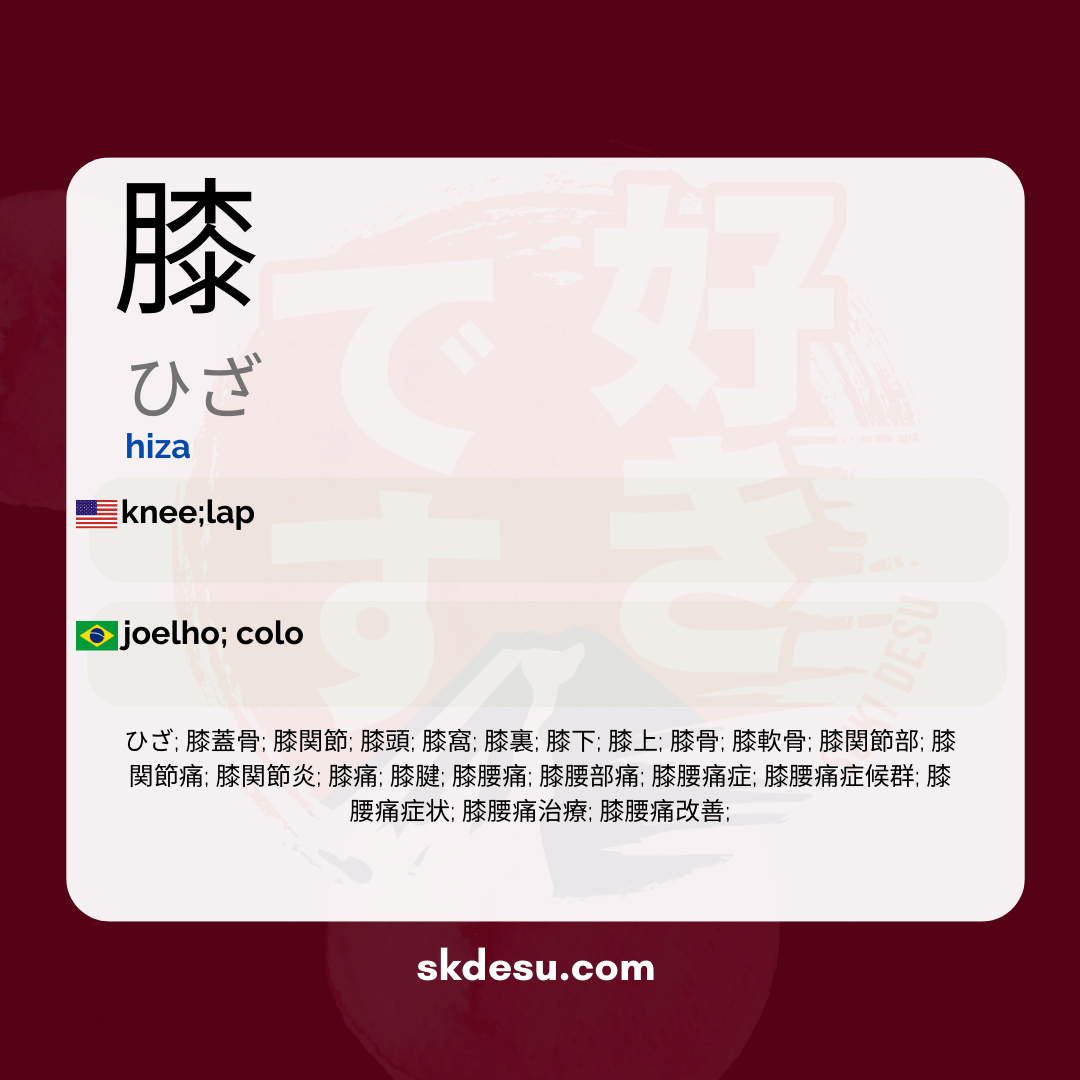Translation and Meaning of: 膝 - hiza
The Japanese word 「膝」 (hiza) refers to the "knee," an important joint in the human body. The kanji "膝" is composed of two radicals: 「⺆」, related to flesh or body, and 「又」, which means "again" or has a connotation of repetition. The combination of these elements in the construction of the kanji provides a visual and semantic perception of the anatomical part of the body, which is a common characteristic in the Japanese language.
The origin of the term "ひざ" dates back to a combination of meanings adapted over time to express the idea of an area of flexibility and articulation in the human body. The concept of the knee, obviously crucial in human movements, was an important consideration in ancient cultures that attributed great significance to body parts in their languages. The use of the word "ひざ" in Japanese is quite common and goes beyond the medical aspect, being applied in expressions related to movements, gestures, and even the way one sits.
In Japanese daily life, "膝" (hiza) frequently appears in expressions and cultural contexts. For example, "膝を打つ" (hiza o utsu) is an idiomatic expression that means "to slap one's knee" and evokes the idea of sudden understanding, similar to "Eureka" in other cultures. Additionally, the knee has significant cultural presence, reflected in traditional practices such as seiza, a way of sitting on one's knees, which is a representation of respect and manners in Japan. This cultural usage enriches the word, showing that it transcends its strictly anatomical use to involve social and behavioral aspects within the Japanese context.
Vocabulary
Expand your vocabulary with related words:
Synonyms and similar words
- ひざ (Hiza) - knee
- 膝蓋骨 (Shizai-kotsu) - Patella (knee bone)
- 膝関節 (Shiza-kansetsu) - Knee articulation
- 膝頭 (Shizagami) - Front of the knee
- 膝窩 (Shizuwaka) - Back of the knee (popliteal)
- 膝裏 (Hizauira) - Back of the knee
- 膝下 (Shizuka) - Below the knee
- 膝上 (Shizajou) - Above the knee
- 膝軟骨 (Shiza-nankotsu) - Knee cartilage
- 膝関節部 (Shiza-kansetsubu) - Knee joint region
- 膝関節痛 (Shiza-kansetsu tsuu) - Knee joint pain
- 膝関節炎 (Shiza-kansetsu en) - Knee arthritis
- 膝痛 (Hizatsuu) - Knee pain
- 膝腱 (Shiza-ken) - Knee tendon
- 膝腰痛 (Hiza-youtsuu) - Lower back pain related to the knee
- 膝腰部痛 (Hiza-youbu tsuu) - Pain in the lower back related to the knee
- 膝腰痛症 (Hiza-youtsuu shou) - Knee-related low back pain syndrome
- 膝腰痛症候群 (Hiza-youtsuu shoukougun) - Knee-related low back pain syndrome
- 膝腰痛症状 (Hiza-youtsuu shoujou) - Symptoms of lower back pain related to the knee
- 膝腰痛治療 (Hiza-youtsuu chiryou) - Treatment for lower back pain related to the knee
- 膝腰痛改善 (Hiza-youtsuu kaizen) - Improvement of lower back pain related to the knee
Related words
Romaji: hiza
Kana: ひざ
Type: noun
L: jlpt-n3
Translation / Meaning: knee; lap
Meaning in English: knee;lap
Definition: The part that connects the legs and hips.
Quick Access
- Vocabulary
- Writing
- Sentences
How to Write in Japanese - (膝) hiza
See below a step-by-step guide on how to write the word by hand in Japanese. (膝) hiza:
Example Sentences - (膝) hiza
See below some example sentences:
Watashi no hiza wa itai desu
My knee hurts.
My knee hurts.
- 私 (watashi) - personal pronoun that means "I"
- の (no) - particle of possession, which indicates that "膝" (hiza) belongs to "私" (watashi)
- 膝 (hiza) - noun meaning "knee"
- は (wa) - topic particle, which indicates that "膝" (hiza) is the subject of the sentence
- 痛い (itai) - adjective meaning "sore" or "sick"
- です (desu) - linking verb that indicates that the sentence is in the present tense and is polite
Other Words of this Type: noun
See other words from our dictionary that are also: noun

